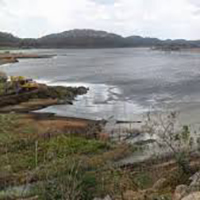Spatio-temporal variation of cyanobacteria and cyanotoxins in public supply reservoirs of the semi-arid region of Brazil
Cyanobacteria and cyanotoxins in reservoirs of the semi-arid region

Accepted: 16 September 2019
HTML: 151
All claims expressed in this article are solely those of the authors and do not necessarily represent those of their affiliated organizations, or those of the publisher, the editors and the reviewers. Any product that may be evaluated in this article or claim that may be made by its manufacturer is not guaranteed or endorsed by the publisher.
Authors
Cyanobacteria harmful algal blooms (CyanoHABs) have become increasingly frequent and intense in public supply reservoirs as a result of eutrophication and global climate change. The semi-arid region of Brazil has a well documented history of CyanoHABs but the underlying factors that control the excessive proliferation of these organisms and the production of their bioactive secondary metabolites are not comprehensively understood. This study aimed to identify the environmental factors that explain the spatial and temporal variations in the abundance of cyanobacteria and the concentration of cyanotoxins (microcystins, saxitoxins, and cylindrospermopsin) in semi-arid reservoirs. The following hypotheses were tested: (a) the largest biovolumes of potential toxin producing cyanobacteria occur when cyanotoxin concentrations are highest; and (b) the environmental factors that explain variations in biovolume of cyanobacteria also explain changes in cyanotoxins concentrations. Samples were taken from four reservoirs located in the Northeast region of Brazil, over a three-month period (October 2016 and February and June 2017). Of the 24 species of cyanobacteria identified, 13 were potentially toxin-producing. Physicochemical variables such as water volume of the reservoir, water transparency, soluble reactive phosphorus, and total phosphorus explained the abundance of cyanobacteria and the levels of cyanotoxins. These results corroborate the hypothesis that similar physicochemical conditions influence the abundance and diversity of cyanobacteria and cyanotoxins. Cyanobacterial blooms composed of more than one potential toxin producing species were observed in the studied reservoirs, where potential microcystin-producing species were the most common. Microcystins and saxitoxins were detected in all the reservoirs studied, while cylindrospermopsin and the cyanobacterium Cylindrospermopsis raciborskii were simultaneously recorded in only one reservoir (Camalaú Reservoir). Cylindrospermopsin was only detected in a reservoir for the first time in the State of Paraíba. Canonical redundancy analysis showed that the cyanotoxins were related to potential toxin producing species. These results corroborate the proposed hypothesis that there is a correlation between cyanotoxins and the biomass of potential producers. Also, there were situations where cyanotoxins were detected without the presence of potential producers. These results demonstrate the need for reassessment of potential toxin producing species of cyanobacteria in semi-arid reservoirs. This may lead to the identification and characterization of novel producers of these bioactive secondary metabolites.
Edited by
Andrea Lami, CNR-IRSA Verbania, ItalyHow to Cite
Similar Articles
- Hu He, Xiaolong Zhu, Xiaolan Song, Erik Jeppesen, Zhengwen Liu, Phytoplankton response to winter warming modified by large-bodied zooplankton: an experimental microcosm study , Journal of Limnology: Vol. 74 No. 3 (2015)
- Javier Sánchez-Hernández, Fernando Cobo, Ontogenetic shifts in terrestrial reliance of stream-dwelling brown trout , Journal of Limnology: Vol. 75 No. 2 (2016)
- Wen Liu, Long Ma, Jinglu Wu, Jilili Abuduwaili, Environmental variability and human activity over the past 140 years documented by sediments of Ebinur Lake in arid central Asia , Journal of Limnology: Vol. 76 No. 3 (2017)
- Svein Birger Wærvågen, Tom Andersen, Seasonal quantitative dynamics and ecology of pelagic rotifers in an acidified boreal lake , Journal of Limnology: Vol. 77 No. 1 (2018)
- Danyang Danyang, Chenhao Li, Lijie Pu, Hugejiletu Hugejiletu, Xiaojing Suo, Ming Zhu, Yalu Zhang, Xiaoqing Wang, Gaili He, Dejing Chen, Changes in and driving factors of the lake area of Huri Chagannao’er Lake in Inner Mongolia , Journal of Limnology: Vol. 81 (2022)
- Franco GIOVANARDI, Richard A. VOLLENWEIDER, Trophic conditions of marine coastal waters: experience in applying the Trophic Index TRIX to two areas of the Adriatic and Tyrrhenian seas , Journal of Limnology: Vol. 63 No. 2 (2004)
- Irina P. Chubarenko, Elena Esiukova, Natalia Stepanova, Boris Chubarenko, Henning Baudler, Down-slope cascading modulated by day/night variations of solar heating , Journal of Limnology: Vol. 72 No. 2 (2013)
- Jong-Yun Choi, Kwang-Seuk Jeong, Geung-Hwan La, Seong-Ki Kim, Gea-Jae Joo, Sustainment of epiphytic microinvertebrate assemblage in relation with different aquatic plant microhabitats in freshwater wetlands (South Korea) , Journal of Limnology: Vol. 73 No. 1 (2014)
- Germán Pérez, Laura Farías, Camila Fernandez, Daniel Conde, Claudia Piccini, Incidence of phytoplankton and environmental conditions on the bacterial ammonium uptake in a subtropical coastal lagoon , Journal of Limnology: Vol. 73 No. 1 (2014)
- Piotr Dabkowski, Paweł Buczynski, Andrzej Zawal, Edyta Stepien, Edyta Buczynska, Robert Stryjecki, Stanislaw Czachorowski, Przemyslaw Smietana, Magdalena Szenejko, The impact of dredging of a small lowland river on water beetle fauna (Coleoptera) , Journal of Limnology: Vol. 75 No. 3 (2016)
<< < 35 36 37 38 39 40 41 42 > >>
You may also start an advanced similarity search for this article.
-
Juliana dos Santos Severiano, Edlayne Rayanara Pontes de Lima, Daniely de Lucena-Silva, Dayrla Kelly Gomes Rocha, Maria Eduarda Santana Veríssimo, Bruno Renaly Souza Figueiredo, José Etham de Lucena Barbosa, Joseline MolozziWater Research : 2023
-
Thiago Santos de Almeida Lopes, Amanda Myrna de Meneses e Costa, Whelton Brito dos Santos, Weruska Brasileiro Ferreira, Patricia Herminio CunhaCadernos Técnicos Engenharia Sanitária e Ambiental : 2023
-
Ranielle Daiana dos Santos-Silva, Juliana dos Santos Severiano, Mathias Ahii Chia, Tatiane Medeiros Queiroz, Micheline Kézia Cordeiro-Araújo, José Etham de Lucena BarbosaEnvironmental Pollution : 2024
-
Flávia Morgana Monteiro, Gustavo Correia de Moura, Juliana dos Santos Severiano, Camila Ferreira Mendes, José Etham de Lucena BarbosaAquatic Ecology : 2021
-
Andreia Souza Regis, Ronaldo Faustino da Silva , Fabio Henrique Portella Corrêa de Oliveira, Eduardo José Alécio de OliveiraRevista de Gestão Social e Ambiental : 2024

 https://doi.org/10.4081/jlimnol.2019.1893
https://doi.org/10.4081/jlimnol.2019.1893





